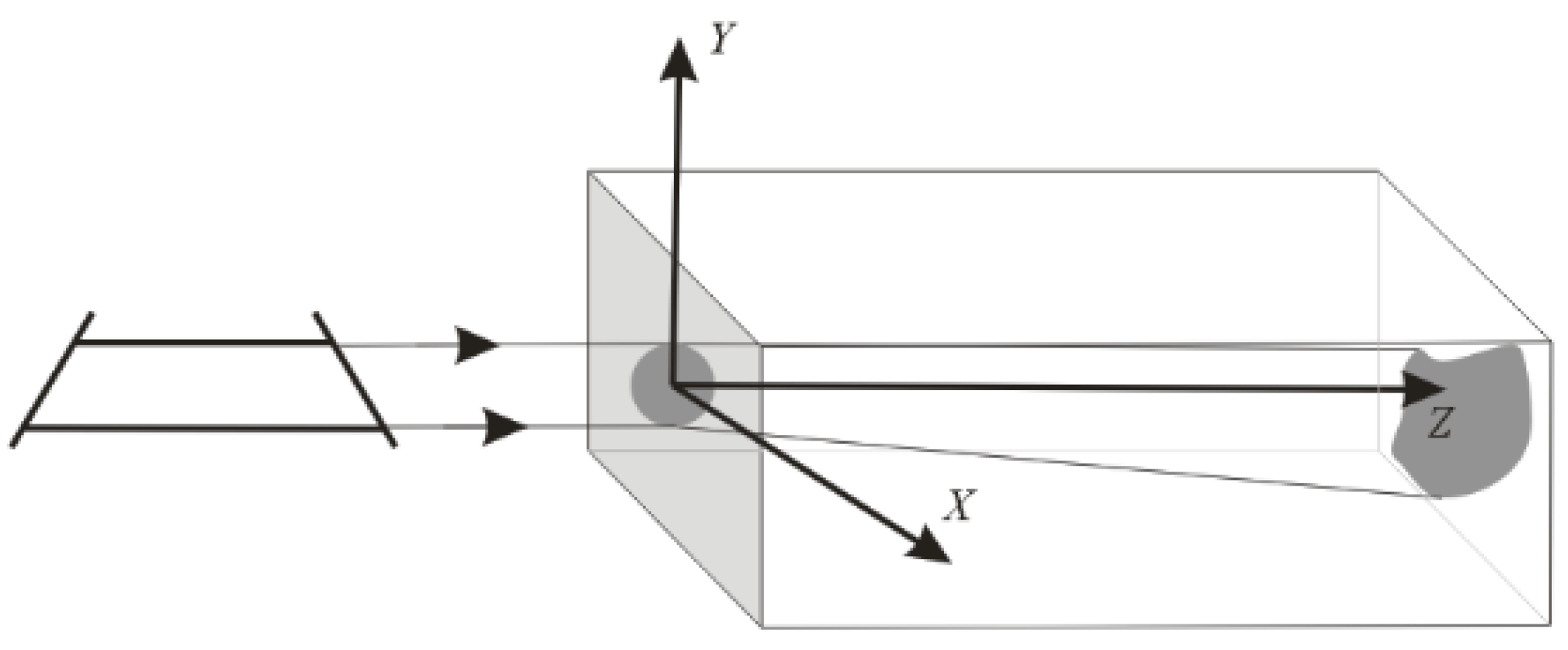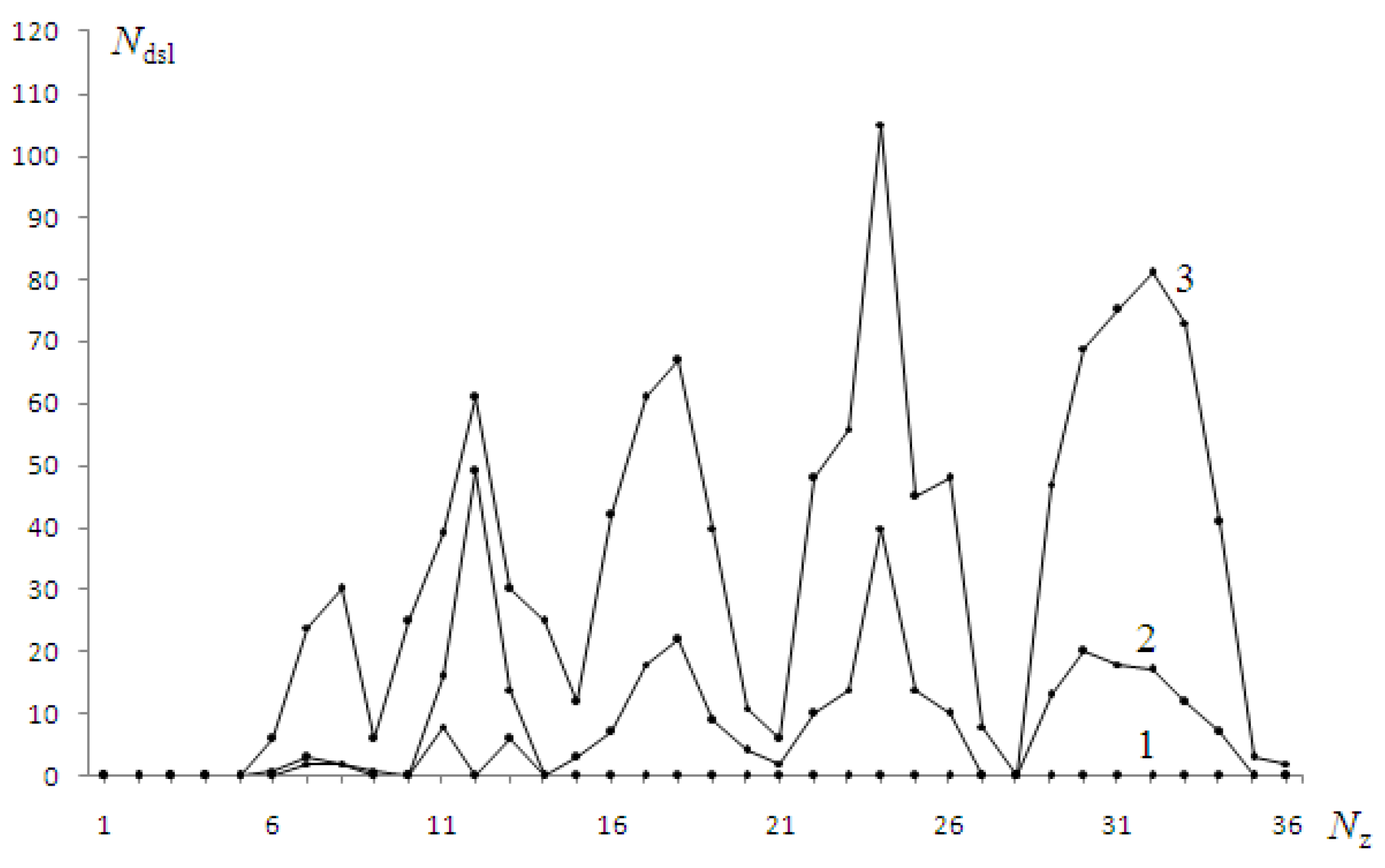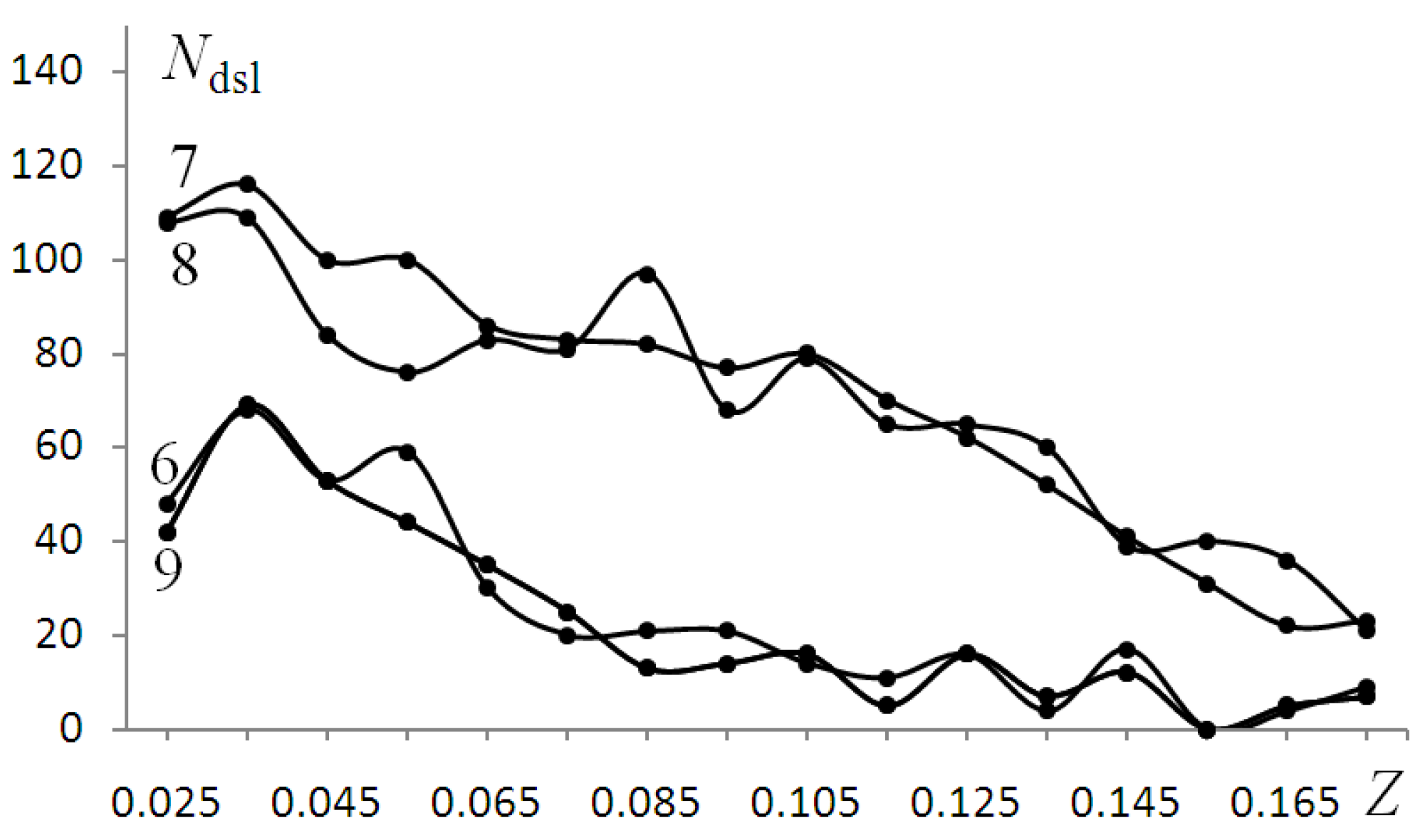Development of Singular Points in a Beam Passed Phase Screen Simulating Atmospheric Turbulence and Precision of Such a Screen Approximation by Zernike Polynomials
Abstract
:1. Introduction
2. Materials and Methods
- Branch cuts are present in an interference pattern of vortex radiation. On this property, the first algorithm was developed.
- Circulation Γ(α) of wavefront gradientsis equal to if an optical vortex falls in an integration contour. The second algorithm was based on this property. Here n is a vortex topological charge and P is the perimeter of the integration contour.
- A vortex is a point of intersections of isolines. Isolines should be drawn in distributions of real and imaginary parts of beam complex amplitude, magnitudes of corresponding functions were equal to zero along the line. On this property, the third algorithm was developed.
3. Obtained Results
4. Discussion
4.1. Scintillations of Amplitude and Emergence of Singular Points in the Wavefront of a Beam with a Phase Set by Zernike Polynomials
4.2. Approximation of the Phase Screen Formed by Zernike Polynomials
4.3. Approximation of a Phase Screen Simulating Atmospheric Distortions
5. Conclusions
- If a phase profile of a beam with Gaussian distribution of amplitude is set by high Zernike polynomials, scintillations of intensity and optical vortices appear in such a beam as a result of propagation. With the increase in propagation distance, the number of vortices changes and decreases.
- Singular points of the wavefront also appear if the phase is set by a screen simulating atmospheric turbulence. Dependence on the path length is approximately the same as in the previous case: corresponding curves oscillate, reach maximums, and go to zero.
- If a phase screen is formed by 9 polynomials and the basis of approximation is formed by the same or greater number of polynomials high precision can be achieved even with computational grids of small dimensions (256 × 256 nodes).
- The quality of approximation decreases if the number of polynomials forming the screen increases (we have considered an increase in numbers up to 12). Absolutely unsatisfying results were observed on grids with small dimensions.
- The precision of the solution can be increased with the increase in the grid dimensions, but even on 2048 × 2048 grid the difference between given and calculated phase profiles (Equation (7)) is about 22%.
Author Contributions
Funding
Institutional Review Board Statement
Informed Consent Statement
Data Availability Statement
Conflicts of Interest
References
- Fried, D.L. Branch point problem in adaptive optics. J. Opt. Soc. Am. A 1998, 15, 2759–2767. [Google Scholar] [CrossRef]
- Vorontsov, M.A.; Kolosov, V.V.; Kohnle, A. Adaptive laser beam projection on an extended target: Phase- and field-conjugate precompensation. J. Opt. Soc. Am. A 2007, 24, 1975–1993. [Google Scholar] [CrossRef] [PubMed]
- Konyaev, P.A.; Lukin, V.P. Computational algorithms for simulations in atmospheric optics. Appl. Opt. 2016, 55, B107–B112. [Google Scholar] [CrossRef] [PubMed]
- Lachinova, S.L.; Vorontsov, M.A. Laser beam projection with adaptive array of fiber collimators. II. Analysis of atmospheric compensation efficiency. J. Opt. Soc. Am. A 2008, 25, 1960–1973. [Google Scholar] [CrossRef] [PubMed]
- Noll, R.J. Zernike polynomials and atmospheric turbulence. J. Opt. Soc. Am. 1976, 66, 207–211. [Google Scholar] [CrossRef]
- Grier, D.G. A revolution in optical manipulation. Nature 2003, 424, 810–816. [Google Scholar] [CrossRef] [PubMed]
- Li, X.; Tai, Y.; Zhang, L.; Li, H.; Li, L. Characterization of dynamic random process using optical vortex metrology. Appl. Phys. B 2014, 116, 901–909. [Google Scholar] [CrossRef]
- Wang, W.; Qiao, Y.; Ishijima, R.; Yokozeki, T.; Honda, D.; Matsuda, A.; Hanson, S.G.; Takeda, M. Constellation of phase singularitie in a specklelike pattern for optical vortex metrology applied to biological kinematic analysis. Opt. Express 2008, 16, 13908–13917. [Google Scholar] [CrossRef] [PubMed]
- Kanev, F.; Aksenov, V.P.; Veretekhin, I.D.; Makenova, N.A. Methods of optical vortex registration. In Proceedings of the 25th International Symposium on Atmospheric and Ocean Optics: Atmospheric Physics, Novosibirsk, Russia, 1–5 July 2019. [Google Scholar]
- Patorski, K.; Pokorski, K. Examination of singular scalar light fields using wavelet processing of fork fringes. Appl. Opt. 2011, 50, 773–781. [Google Scholar] [CrossRef] [PubMed]
- Angelsky, O.V.; Maksimyak, A.P.; Maksimyak, P.P.; Hanson, S.G. Spatial Behaviour of Singularities in Fractal-and Gaussian Speckle Fields. Open Opt. J. 2009, 3, 29–43. [Google Scholar] [CrossRef] [Green Version]
- Nye, J.F. Natural Focusing and Fine Structure of Light: Caustics and Wave Dislocations; Institute of Physics Publishing: Bristol, PA, USA; Philadelphia, PA, USA, 1999; 328p. [Google Scholar]
- Svechnikov, M.V.; Chkhalo, N.I.; Toropov, M.N.; Salashchenko, N.N. Resolving capacity of the circular Zernike polynomials. Opt. Express 2015, 23, 14677–14693. [Google Scholar] [CrossRef] [PubMed]
- Chaudhary, V.; Abhilash, A. Literature review: Mitigation of atmospheric turbulence on long distance imaging system with various methods. Int. J. Sci. Res. 2012, 3, 2227–2231. [Google Scholar]
- Andrews, L.C.; Phillips, R.L. Laser Beam Propagation through Random Media, 2nd ed.; SPIE Press Book: Bellingham, WA, USA, 2005; 808p. [Google Scholar]
- Heideman, M.T.; Johnson, D.H.; Burrus, C.S. Gauss and the history of the Fast Fourier Transform. IEEE ASSP Mag. 1984, 1, 14–21. [Google Scholar] [CrossRef] [Green Version]
- Lippman, S.B.; Lajoie, J.; Moo, B.E. C++ Primer, 5th ed.; Addison-Wesley: Boston, MA, USA, 2013; 938p. [Google Scholar]
- Gui, G.; Adachi, F. Improved least mean square algorithm with application to adaptive sparse channel estimation. EURASIP J. Wirel. Commun. Netw. 2013, 2013, 204. [Google Scholar] [CrossRef] [Green Version]
















| Parameters | CZ1 | CZ2 | CZ3 | CZ4 | CZ5 | … | CZ9 | J | εPh | εA | REff | Xc | Yc |
|---|---|---|---|---|---|---|---|---|---|---|---|---|---|
| Number of the column | 1 | 2 | 3 | 4 | 5 | 6 | 7 | 8 | 9 | 10 | 11 | 12 | 13 |
| Values of parameters corresponding to the given phase | 1.00 | 1.00 | 1.50 | 1.00 | 0.50 | … | 1.00 | 0.51 | 0.00 | 0.00 | 1.86 | 0.36 | −0.36 |
| Values obtained as a result of approximation | 1.00 | 1.00 | −6.11 | 1.00 | −7.10 | … | 1.00 | 0.51 | 0.00 | 0.00 | 1.86 | 0.36 | −0.36 |
| Parameters | CZ1 | CZ2 | CZ3 | CZ4 | CZ5 | … | CZ9 | J | εPh | εA | REff | Xc | Yc |
|---|---|---|---|---|---|---|---|---|---|---|---|---|---|
| Number of the column | 1 | 2 | 3 | 4 | 5 | 6 | 7 | 8 | 9 | 10 | 11 | 12 | 13 |
| Values of parameters corresponding to the given phase | 1.00 | 1.00 | 1.50 | 1.00 | 0.50 | … | 1.00 | 0.51 | 0.00 | 0.00 | 1.86 | 0.36 | −0.36 |
| Values obtained as a result of approximation | 1.00 | 1.00 | −6.11 | 1.00 | −7.11 | … | 1.00 | 0.51 | 0.00 | 0.00 | 1.86 | 0.36 | −0.36 |
| Parameters | CZ1 | CZ2 | CZ3 | CZ4 | CZ5 | … | CZ12 | J | εPh | εA | REff | Xc | Yc |
|---|---|---|---|---|---|---|---|---|---|---|---|---|---|
| Number of the column | 1 | 2 | 3 | 4 | 5 | 6 | 7 | 8 | 9 | 10 | 11 | 12 | 13 |
| Values of parameters corresponding to the given phase | 1.00 | 1.00 | 1.50 | 1.00 | 0.50 | … | 1.00 | 0.52 | 0.00 | 0.00 | 2.35 | 0.07 | −0.07 |
| Values obtained as a result of approximation | 19.27 | −3.9 | −1452.1 | 1.00 | −1413.1 | … | 1.00 | 0.18 | 4.10 | 0.69 | 3.21 | 0.44 | 0.39 |
| Parameters | CZ1 | CZ2 | CZ3 | CZ4 | CZ5 | … | CZ12 | J | εPh | εA | REff | Xc | Yc |
|---|---|---|---|---|---|---|---|---|---|---|---|---|---|
| Number of the column | 1 | 2 | 3 | 4 | 5 | 6 | 7 | 8 | 9 | 10 | 11 | 12 | 13 |
| Values of parameters corresponding to the given phase | 1.00 | 1.00 | 1.50 | 1.00 | 0.50 | … | 1.00 | 0.53 | 0.00 | 0.00 | 2.25 | 0.06 | −0.07 |
| Values obtained as a result of approximation | 0.95 | 0.77 | 952.22 | 1.00 | 960.12 | … | 1.00 | 0.54 | 0.22 | 0.14 | 2.24 | 0.06 | −0.07 |
| Parameters | CZ1 | CZ2 | CZ3 | CZ4 | CZ5 | … | CZ8 | J | εPh | εA | REff | Xc | Yc |
|---|---|---|---|---|---|---|---|---|---|---|---|---|---|
| Number of the column | 1 | 2 | 3 | 4 | 5 | 6 | 7 | 8 | 9 | 10 | 11 | 12 | 13 |
| Values of parameters corresponding to the given phase | 1.00 | 1.00 | 1.00 | 1.00 | 1.00 | … | 1.00 | 0.52 | 0.00 | 0.00 | 2.35 | 0.56 | −0.41 |
| Values obtained as a result of approximation | 46.61 | 1.00 | 17.83 | 1.00 | 17.83 | … | 1.00 | 0.13 | 8.19 | 0.69 | 3.47 | 1.95 | −0.36 |
| Parameters | εPh | εAmp | J | ShX | ShY | REffX | REffY | REff |
|---|---|---|---|---|---|---|---|---|
| Number of the column | 1 | 2 | 3 | 4 | 5 | 6 | 7 | 8 |
| Values of parameters corresponding to the given phase | 0 | 0 | 0.988 | 0.043 | 0.019 | 0.053 | 0.084 | 0.099 |
| Values obtained as a result of approximation | 0.208 | 0.291 | 0.986 | 0.043 | 0.019 | 0.077 | 0.075 | 0.107 |
| Parameters | εPh | εAmp | J | ShX | ShY | REffX | REffY | REff |
|---|---|---|---|---|---|---|---|---|
| Number of the column | 1 | 2 | 3 | 4 | 5 | 6 | 7 | 8 |
| Values of parameters corresponding to the given phase | 0 | 0 | 0.983 | 0.076 | 0.035 | 0.038 | 0.092 | 0.100 |
| Values obtained as a result of approximation | 0.208 | 0.544 | 0.980 | 0.076 | 0.035 | 0.085 | 0.078 | 0.114 |
| Parameters | εPh | εAmp | J | ShX | ShY | REffX | REffY | REff |
|---|---|---|---|---|---|---|---|---|
| Number of the column | 1 | 2 | 3 | 4 | 5 | 6 | 7 | 8 |
| Values of parameters corresponding to | 0 | 0 | 0.965 | 0.076 | −0.149 | 0.039 | 0.081 | 0.090 |
| Values obtained as a result of approximation | 0.244 | 0.675 | 0.955 | 0.076 | −0.135 | 0.093 | 0.122 | 0.153 |
Publisher’s Note: MDPI stays neutral with regard to jurisdictional claims in published maps and institutional affiliations. |
© 2022 by the authors. Licensee MDPI, Basel, Switzerland. This article is an open access article distributed under the terms and conditions of the Creative Commons Attribution (CC BY) license (https://creativecommons.org/licenses/by/4.0/).
Share and Cite
Kanev, F.; Makenova, N.; Veretekhin, I. Development of Singular Points in a Beam Passed Phase Screen Simulating Atmospheric Turbulence and Precision of Such a Screen Approximation by Zernike Polynomials. Photonics 2022, 9, 285. https://doi.org/10.3390/photonics9050285
Kanev F, Makenova N, Veretekhin I. Development of Singular Points in a Beam Passed Phase Screen Simulating Atmospheric Turbulence and Precision of Such a Screen Approximation by Zernike Polynomials. Photonics. 2022; 9(5):285. https://doi.org/10.3390/photonics9050285
Chicago/Turabian StyleKanev, Feodor, Nailya Makenova, and Igor Veretekhin. 2022. "Development of Singular Points in a Beam Passed Phase Screen Simulating Atmospheric Turbulence and Precision of Such a Screen Approximation by Zernike Polynomials" Photonics 9, no. 5: 285. https://doi.org/10.3390/photonics9050285
APA StyleKanev, F., Makenova, N., & Veretekhin, I. (2022). Development of Singular Points in a Beam Passed Phase Screen Simulating Atmospheric Turbulence and Precision of Such a Screen Approximation by Zernike Polynomials. Photonics, 9(5), 285. https://doi.org/10.3390/photonics9050285




